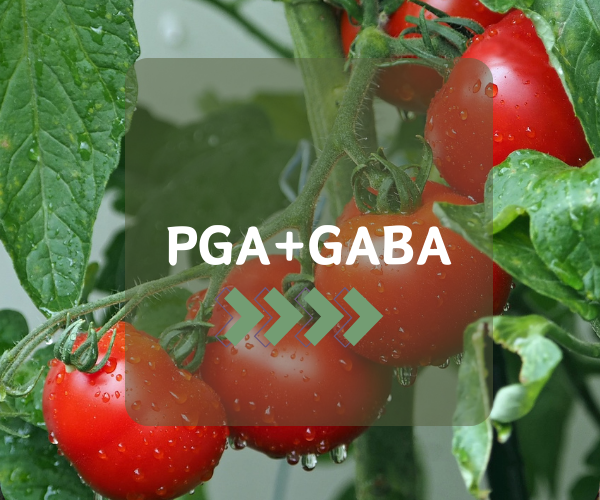Polyglutamic Acid (PGA) and Gamma-Aminobutyric Acid (GABA) are two natural compounds that, when combined, offer powerful synergistic effects to enhance crop yield and resilience. Polyglutamic acid, derived from glutamic acid, is a biodegradable polypeptide known for its water-solubility and effectiveness in agriculture. GABA, a non-protein amino acid, plays a crucial role in regulating plant growth and metabolic processes. This article explores the benefits of using PGA and GABA together in agriculture, from improving photosynthesis and nutrient metabolism to enhancing plants’ stress tolerance and soil health. Additionally, it provides detailed application methods and dosage recommendations for various crops, emphasizing eco-friendly and sustainable practices.
Introduction
In modern agriculture, achieving high yield while ensuring environmental sustainability has become a major challenge. Innovative solutions such as Polyglutamic Acid (PGA) and Gamma-Aminobutyric Acid (GABA) offer promising results. These two bioactive compounds, when used in tandem, provide plants with enhanced growth, improved stress resistance, and optimized nutrient use. This article will dive into the synergistic effects of PGA and GABA, offering insights into their individual and combined benefits for a wide range of crops.
Synergistic Benefits of Polyglutamic Acid and GABA
- Double Impact on Growth and Metabolism
PGA increases chlorophyll content and improves photosynthesis, boosting organic matter production. GABA, on the other hand, enhances plant metabolism by regulating cellular osmotic pressure and nitrogen-carbon metabolism. Together, they accelerate plant growth and dry matter accumulation. For instance, PGA thickens and greens leaves, while GABA facilitates nutrient transfer to fruits, improving both yield and quality. - Enhanced Stress Tolerance for Challenging Environments
One of the key benefits of PGA is its ability to stabilize cell membranes and induce antioxidant enzyme activity, enhancing plants’ resistance to cold and drought stress. GABA further supports this by balancing ion concentrations, reducing sodium ion toxicity, and promoting proline accumulation, helping plants endure salt and alkali stress. When combined, PGA and GABA can increase crop survival rates in extreme weather conditions and saline-alkaline soils by over 30%. - Soil Improvement and Efficient Nutrient Utilization
PGA acts as a chelating agent that reduces nutrient fixation in soil, improving nitrogen fertilizer efficiency by up to 60.3%. GABA promotes the secretion of organic acids by plant roots, which in turn activates difficult-to-dissolve phosphates and potassium in the soil. Together, these compounds not only reduce fertilizer use by up to 20%, but also improve soil structure by alleviating compaction and enhancing the formation of soil aggregates. - Eco-Friendly and Safe for Organic Farming
Both PGA and GABA are biodegradable, leaving no harmful residues. PGA decomposes into glutamic acid, which plants can directly absorb, while GABA serves as a natural signaling molecule, regulating plant physiological processes. The use of these compounds reduces the dependency on chemical pesticides, aligning with the growing demand for organic farming solutions.
Application Methods and Dosage Recommendations
1. Leafy Vegetables (e.g., Spinach, Lettuce)
- Compound Ratio: Polyglutamic Acid : GABA = 3 : 1
- Usage Method:
- Base Fertilizer: Apply 30g of Polyglutamic Acid + 10g of GABA per acre, mixed with organic fertilizer.
- Foliar Spray: Dilute 1000 times (20g of Polyglutamic Acid + 7g of GABA per acre). Spray at the seedling stage and again 15 days before harvest.
- Effects: Leaf thickness increases by 20%, nitrate content decreases by 15%, and harvest is accelerated by 5-7 days.
2. Root and Tuber Crops (e.g., Potatoes, Carrots)
- Compound Ratio: Polyglutamic Acid : GABA = 5 : 2
- Usage Method:
- Drip Irrigation: Apply 50g of Polyglutamic Acid + 20g of GABA per acre in three applications: at sowing, early tuber swelling, and mid-growth.
- Soil Amendment: Mix with humic acid and apply 40g of Polyglutamic Acid + 15g of GABA per acre to alleviate continuous cropping problems.
- Effects: Tuber yield increases by 60%, starch content rises by 8%, and resistance to soil-borne diseases increases by 125%.
3. Fruit Trees (e.g., Citrus, Apples)
- Compound Ratio: Polyglutamic Acid : GABA = 4 : 1
- Usage Method:
- Flowering Period: Spray diluted to 800 times (40g of Polyglutamic Acid + 10g of GABA per acre) to reduce flower and fruit drop.
- Fruit Color Development: Apply root irrigation with 60g of Polyglutamic Acid + 15g of GABA per acre to promote sugar accumulation.
- Effects: Sugar content increases by 2-3 degrees, and fruit cracking is reduced by 40%.
The combination of Polyglutamic Acid and GABA offers a powerful tool for enhancing crop yield, stress resistance, and nutrient utilization. With eco-friendly benefits and a wide range of application methods tailored to various crops, this innovative solution is set to revolutionize sustainable agriculture. By integrating these natural compounds into farming practices, growers can achieve higher productivity, healthier crops, and reduced environmental impact.


